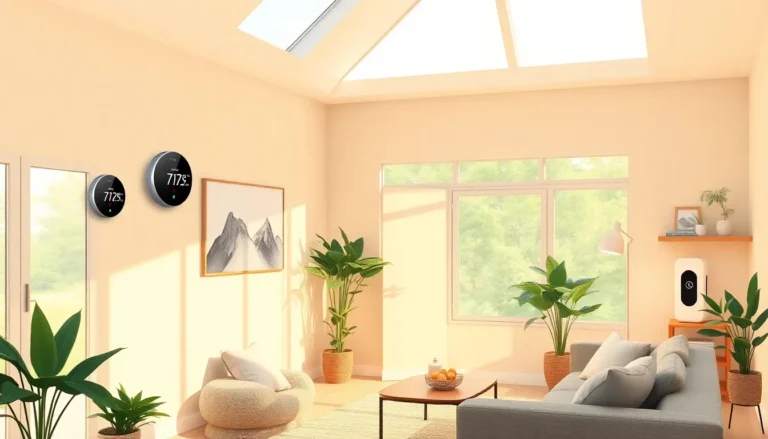Imagine walking into a room and having the lights flick on without lifting a finger. Sounds like magic, right? Welcome to the world of hands-free lighting, where convenience meets innovation. Gone are the days of fumbling for switches like a contestant on a game show. With a simple voice command or a wave of your hand, you can illuminate your space and impress your guests, all while keeping your hands free for more important tasks—like holding that slice of pizza.
Hands-free lighting isn’t just about being lazy; it’s about embracing a smarter way to live. Whether you’re juggling groceries or trying to find your favorite book in a dimly lit corner, this technology makes life a little brighter—literally. So, let’s dive into the benefits, types, and tips for using hands-free lighting to transform your home into a beacon of efficiency and style.
Table of Contents
ToggleOverview Of Hands Free Lighting
Hands-free lighting represents a shift toward smarter home technology. Users can control lighting with voice commands or gestures, enhancing convenience. Smart speakers and motion sensors play a critical role in this setup. Such devices integrate seamlessly with existing home automation systems.
Voice-activated systems, like Amazon Alexa or Google Assistant, enable users to adjust brightness or turn lights on and off easily. Gesture control also provides an alternative, allowing individuals to wave their hands to switch lights. Emphasizing accessibility, hands-free lighting benefits everyone, particularly those with mobility challenges.
Smart LED bulbs are a popular choice for hands-free lighting. They offer energy efficiency and longevity, significantly reducing electricity consumption. Users often appreciate the customization options, which allow ambiance adjustments based on mood or activity.
Integration with other smart home devices enhances the experience. For example, connecting hands-free lighting to security systems can activate lights automatically during an emergency. Enhanced safety measures create a more secure living environment.
Installation processes typically remain straightforward. Many systems require minimal wiring, making them appealing for DIY enthusiasts. Comprehensive guides often accompany products, ensuring a smooth setup.
Hands-free lighting represents more than just convenience; it symbolizes a modern approach to home living. Innovative technology continues to evolve, presenting endless possibilities. Utilizing hands-free lighting can transform daily routines, making tasks more efficient and enjoyable.
Advantages Of Hands Free Lighting

Hands-free lighting offers numerous benefits that greatly enhance everyday living. This technology stands out for its ability to transform mundane tasks into seamless experiences.
Enhanced Convenience
Ease of use defines hands-free lighting. Users can control lights with simple voice commands or gestures. Carrying groceries becomes hassle-free when lights respond without needing to reach for switches. Adjusting brightness while cooking or reading promotes a more comfortable environment effortlessly. Hands-free options also accommodate busy lifestyles; individuals can enter or exit rooms, and lights activate automatically. Smart LED bulbs enhance this experience, adjusting colors and intensities easily, making every moment more enjoyable.
Improved Safety
Safety benefits significantly from hands-free lighting systems. Motion sensors trigger lights automatically, illuminating spaces in low visibility. This feature proves crucial during emergencies, where immediate light can prevent accidents. Individuals with mobility challenges find added security, as they don’t need to navigate dark areas without assistance. Furthermore, integration with security systems enhances home protection; lights can turn on to deter intruders. Improved visibility contributes to overall safety for families and visitors, ensuring a secure and welcoming environment.
Types Of Hands Free Lighting
Hands-free lighting comes in various forms, providing users with flexibility and functionality. Two prominent types of hands-free lighting include motion sensor lights and voice-activated lights.
Motion Sensor Lights
Motion sensor lights activate automatically when they detect movement. These lights provide energy efficiency as they only operationalize upon detecting an individual, conserving electricity during inactive periods. Many models offer customization, such as setting timers or adjusting sensitivity levels, to suit specific environments. Homes often benefit from their presence, especially in hallways or entryways, as they enhance safety and visibility. Moreover, individuals with mobility challenges may find these lights particularly advantageous since they eliminate the need to manually switch lights on or off.
Voice-Activated Lights
Voice-activated lights allow control through spoken commands. Users can connect these lights to smart home systems like Amazon Alexa or Google Assistant, enabling seamless operation. Adjusting brightness or turning lights on and off occurs effortlessly, facilitating multitasking during daily routines. Voice-activated systems increase accessibility, especially for those with physical limitations. Additionally, users can set lighting schedules or create specific ambiance settings through verbal instructions. The convenience offered by voice-activated lights transforms typical lighting interactions, making them more intuitive and user-friendly.
Applications Of Hands Free Lighting
Hands-free lighting finds numerous applications, enhancing convenience in both home and commercial settings. Its adaptable nature makes it suitable for various environments.
Home Use
Hands-free lighting proves invaluable in residential spaces. Voice-activated systems allow users to adjust light settings based on activities or moods. For example, while cooking, saying a command increases brightness, transforming the kitchen environment. Motion sensor lights illuminate pathways automatically, ensuring visibility when entering dark rooms. Families benefit significantly when carrying items, as these lights turn on without needing to flip a switch. Individuals with mobility challenges find hands-free lighting especially helpful, promoting independence and safety within the home.
Commercial Use
Hands-free lighting plays a pivotal role in commercial spaces. Retail environments utilize motion sensors to adjust lighting based on customer foot traffic, providing energy efficiency. Voice commands facilitate quick adjustments during events, enhancing overall experiences. Restaurants enjoy the benefit of seamless transitions in lighting for different dining atmospheres, creating a specific ambiance instantly. Additionally, offices utilize hands-free options to maintain productivity while reducing energy costs. The integration of this technology in security systems benefits businesses by ensuring safe navigation in low-light areas, offering a secure working environment for employees.
Hands-free lighting is revolutionizing how people interact with their environments. By providing effortless control through voice commands and motion sensors, it simplifies daily tasks and enhances safety. This technology not only caters to convenience but also promotes accessibility for everyone, particularly those with mobility challenges.
As smart home technology continues to evolve, hands-free lighting stands out as a key player in creating efficient and enjoyable living spaces. Its integration with other devices further amplifies its benefits, ensuring homes are not just smarter but also safer. Embracing hands-free lighting is a step toward a more connected and user-friendly lifestyle.








